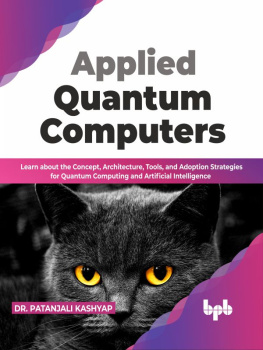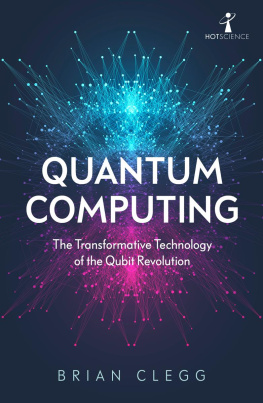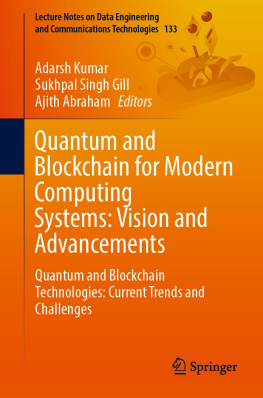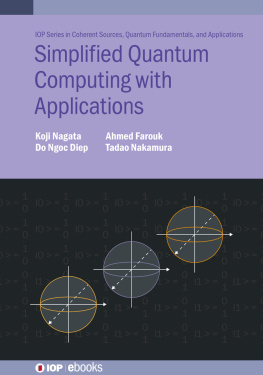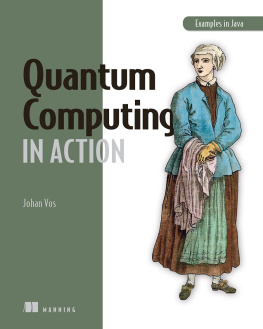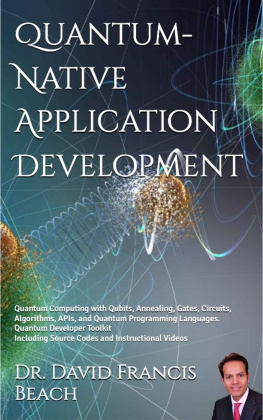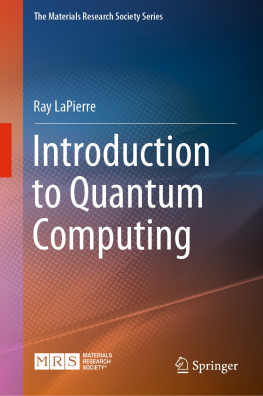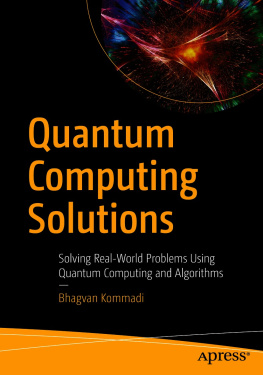Alex Khan - Quantum Computing Experimentation with Amazon Braket
Here you can read online Alex Khan - Quantum Computing Experimentation with Amazon Braket full text of the book (entire story) in english for free. Download pdf and epub, get meaning, cover and reviews about this ebook. year: 2022, publisher: Packt Publishing Pvt Ltd, genre: Home and family. Description of the work, (preface) as well as reviews are available. Best literature library LitArk.com created for fans of good reading and offers a wide selection of genres:
Romance novel
Science fiction
Adventure
Detective
Science
History
Home and family
Prose
Art
Politics
Computer
Non-fiction
Religion
Business
Children
Humor
Choose a favorite category and find really read worthwhile books. Enjoy immersion in the world of imagination, feel the emotions of the characters or learn something new for yourself, make an fascinating discovery.
- Book:Quantum Computing Experimentation with Amazon Braket
- Author:
- Publisher:Packt Publishing Pvt Ltd
- Genre:
- Year:2022
- Rating:4 / 5
- Favourites:Add to favourites
- Your mark:
- 80
- 1
- 2
- 3
- 4
- 5
Quantum Computing Experimentation with Amazon Braket: summary, description and annotation
We offer to read an annotation, description, summary or preface (depends on what the author of the book "Quantum Computing Experimentation with Amazon Braket" wrote himself). If you haven't found the necessary information about the book — write in the comments, we will try to find it.
Alex Khan: author's other books
Who wrote Quantum Computing Experimentation with Amazon Braket? Find out the surname, the name of the author of the book and a list of all author's works by series.
Quantum Computing Experimentation with Amazon Braket — read online for free the complete book (whole text) full work
Below is the text of the book, divided by pages. System saving the place of the last page read, allows you to conveniently read the book "Quantum Computing Experimentation with Amazon Braket" online for free, without having to search again every time where you left off. Put a bookmark, and you can go to the page where you finished reading at any time.
Font size:
Interval:
Bookmark:

Explore Amazon Braket quantum computing to solve combinatorial optimization problems
Alex Khan

BIRMINGHAMMUMBAI
Copyright 2022 Packt Publishing
All rights reserved. No part of this book may be reproduced, stored in a retrieval system, or transmitted in any form or by any means, without the prior written permission of the publisher, except in the case of brief quotations embedded in critical articles or reviews.
Every effort has been made in the preparation of this book to ensure the accuracy of the information presented. However, the information contained in this book is sold without warranty, either express or implied. Neither the author, nor Packt Publishing or its dealers and distributors, will be held liable for any damages caused or alleged to have been caused directly or indirectly by this book.
Packt Publishing has endeavored to provide trademark information about all of the companies and products mentioned in this book by the appropriate use of capitals. However, Packt Publishing cannot guarantee the accuracy of this information.
Group Product Manager: Pavan Ramchandani
Publishing Product Manager: Kushal Dave
Senior Editor: Keagan Carneiro
Content Development Editor: Adrija Mitra
Technical Editor: Saurabh Kadave
Copy Editor: Safis Editing
Project Coordinator: Rashika Ba
Proofreader: Safis Editing
Indexer: Tejal Daruwale Soni
Production Designer: Jyoti Chauhan
Marketing Coordinator: Sonakshi Bubbar
First published: July 2022
Production reference: 1290722
Published by Packt Publishing Ltd.
Livery Place
35 Livery Street
Birmingham
B3 2PB, UK.
978-1-80056-526-5
www.packt.com
To my family and friends who have suffered through my crazy ideas and tangents; believe it or not, it is you who inspire me to take risks and be myself.
To the authors, researchers, and entrepreneurs in quantum computing who have taken the time to share their wisdom and stories with the rest of us.
And, to you, my reader, since you are curious and taking a chance. It is my hope that this book will help to clarify some aspects of a complicated discipline.
Alex Khan
It is truly an honor to receive a request to write a foreword for a book like this, in this particular space, at this specific time in history, and by a colleague whom I believe will make significant contributions to this industry during his tenure. That book is Quantum Computing Experimentation with Amazon Braket, the space is quantum computing, the time in history is the infancy of an advanced technology that realistically expects the change the world, and my colleague is Alex Khan.
Alex and I got involved with quantum computing at roughly the same time, and with connections and collaborations with other esteemed colleagues in the domain, such as Dr. Keeper Lane Sharkey, we all began our journey in this space, making contributions where our respective talents best positioned us to: Alex in the quantum start-up, education, and consultancy space; Keeper in the quantum chemistry space; and I brought quantum computing to a fortune-five health company with 350,000 global employees and continue to lead the quantum efforts there.
Its not surprising to see contributions by industry leaders such as Alex manifested in books of this nature and undergirded by quantum vendors such as AWS, who bring significant and diverse computational capabilities to the table. The fusion of these two actors in the wild brings a richness to both the educational process and the process of developing valued industry skills, resulting in a far better outcome for the individual, and this is likely to be a key training model in the quantum space moving forward.
The books focus is as the title suggests: its a journey to explore and experiment with quantum computing using the Amazon Braket experience. This is appealing to both the neophyte and the experienced practitioner, as the latter will procure a solid tactical vendor education through a digestible and methodical pedagogy, and the former will get that plus an introduction to quantum basics as well. Readers will explore advanced topics in the later chapters, which is the ultimate commission of the book: to show real-world applications.
The book begins with the mechanics and specifics of the AWS platform, which is both necessary and wise since AWS brings an infrastructure as code approach to quantum computing, in addition to being the only vendor to make multiple quantum hardware architectures available under one cost-effective platform. This is important to industries in the wild seeking to get into quantum because experimentation now becomes an OpEx (operational expenditure) as opposed to a CapEx (capital expenditure), and that significantly lowers the entry price to quantum experimentation and increases the potential for senior leadership buy-in. Practitioners developing quantum capabilities on that framework will have more highly valued skill sets in the marketplace because of the exposure to multiple hardware platforms, as each platform brings something unique and different to the table when it comes to solving problems.
This book also provides a solid introduction to and overview of the two different quantum architectures (gate-based and annealing) and how to use them. The differences between the architectural variants within the gate-based architectures are significant, but nuanced. The differences between the annealing and the gate-based architectures are significant and glaring. The practitioner who gets hands-on experience in comparing and contrasting these two significantly different architectures and how they relate to specific use cases will have developed valuable capabilities. To this end, the book provides a solid journey through the D-Wave, OQC, IonQ, and Rigetti quantum architectures.
This book does a great job of weaving together specific use cases with general quantum education in the flow of its content. Thats a non-trivial task since the annealing architecture is so different than the gate-based architectures, and the ways of conceptualizing the problems (and solutions) vary significantly between any architecture being used, particularly at the algorithm level.
This book spends a decent amount of time on advanced subjects such as QAOA, QUBO, and hybrid algorithms, doing a solid job of laying out the use cases under consideration and how the various architectures would be used to address those subjects at a tactical level. This approach is particularly helpful when addressing the single versus multiple objective optimization use case as it highlights the differences between the annealing approach and the gate-based approach, something thats found in later chapters.
The quantum computing space is following a very similar maturation trajectory to the classical computing space in that it begins in the lab and ends in the hands of the consumer. We call that the producer/consumer difference. The producers make the technology, and the consumers use it to solve real problems in the wild. The consumers can only make proper use of the technology when both it and their understanding of how to effectively use it reach a certain level of maturity. The time between when producers mature the technology enough for consumers to effectively engage it can be viewed as eras, and certain seminal events have to occur before computation moves from one era to another. The classical illustration of one of those seminal events of this is when Dennis Ritchie invented C and UNIX, which enabled classical computing to move out from the labs and into the hands of the consumer.
Font size:
Interval:
Bookmark:
Similar books «Quantum Computing Experimentation with Amazon Braket»
Look at similar books to Quantum Computing Experimentation with Amazon Braket. We have selected literature similar in name and meaning in the hope of providing readers with more options to find new, interesting, not yet read works.
Discussion, reviews of the book Quantum Computing Experimentation with Amazon Braket and just readers' own opinions. Leave your comments, write what you think about the work, its meaning or the main characters. Specify what exactly you liked and what you didn't like, and why you think so.


